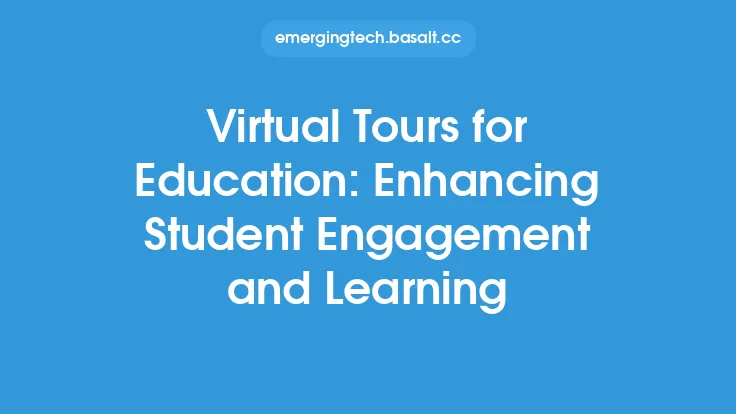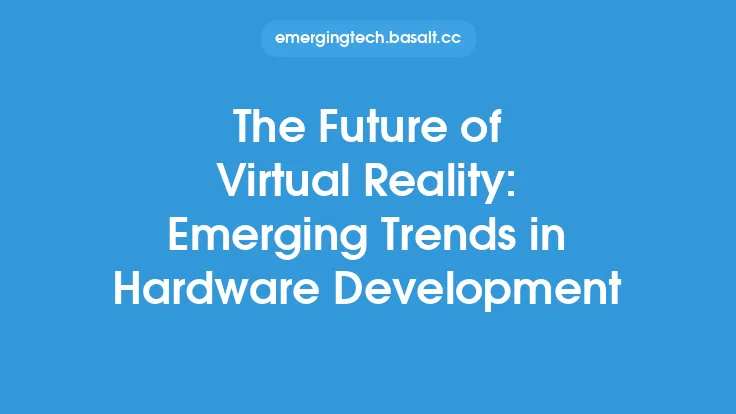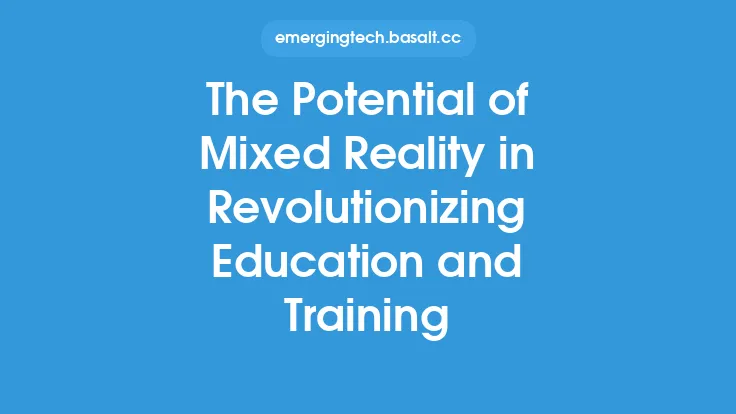The use of virtual reality (VR) in education is a rapidly growing trend that has the potential to revolutionize the way we learn. By providing an immersive and interactive experience, VR can enhance the learning process, increase student engagement, and improve academic outcomes. In this article, we will explore the benefits and applications of VR in education, as well as the technical aspects of implementing VR in the classroom.
Introduction to Virtual Reality in Education
Virtual reality in education refers to the use of computer-generated simulations to create a virtual environment that mimics real-world experiences. This can include everything from virtual field trips to interactive simulations of complex scientific concepts. By using VR, educators can create a more engaging and interactive learning experience that can help students to better understand and retain complex information. VR can also provide students with the opportunity to explore and interact with virtual objects and environments in a way that would be impossible in the physical world.
Benefits of Virtual Reality in Education
The benefits of VR in education are numerous and well-documented. Some of the most significant advantages of using VR in the classroom include:
- Increased student engagement: VR can help to increase student motivation and engagement by providing a more interactive and immersive learning experience.
- Improved academic outcomes: Studies have shown that students who use VR in the classroom tend to perform better academically than those who do not.
- Enhanced retention: VR can help students to better retain complex information by providing a more interactive and memorable learning experience.
- Cost-effective: VR can provide a cost-effective alternative to traditional teaching methods, such as field trips and lab experiments.
- Accessibility: VR can provide students with disabilities or limitations with access to educational experiences that would be impossible for them to participate in otherwise.
Applications of Virtual Reality in Education
VR can be applied in a wide range of educational settings, from elementary school to university level. Some examples of VR applications in education include:
- Virtual field trips: VR can provide students with the opportunity to explore and interact with virtual environments that would be impossible or impractical to visit in person.
- Interactive simulations: VR can be used to create interactive simulations of complex scientific concepts, such as the human body or the solar system.
- Language learning: VR can provide students with the opportunity to practice their language skills in a virtual environment that simulates real-world conversations and interactions.
- History and social studies: VR can be used to recreate historical events and environments, providing students with a more immersive and engaging learning experience.
- STEM education: VR can be used to create interactive simulations of complex STEM concepts, such as physics and engineering.
Technical Aspects of Virtual Reality in Education
Implementing VR in the classroom requires a range of technical equipment and software. Some of the most common VR technologies used in education include:
- Head-mounted displays (HMDs): HMDs are wearable devices that provide students with a virtual environment to explore and interact with.
- Controllers: Controllers are used to interact with virtual objects and environments, and can include everything from simple buttons to complex gesture recognition systems.
- Sensors: Sensors are used to track the student's movements and provide a more immersive and interactive experience.
- Software: VR software is used to create and deliver virtual environments and experiences to students. This can include everything from simple 3D models to complex simulations and games.
Challenges and Limitations of Virtual Reality in Education
While VR has the potential to revolutionize the way we learn, there are also several challenges and limitations to its adoption in education. Some of the most significant challenges include:
- Cost: VR equipment and software can be expensive, making it inaccessible to many schools and educators.
- Technical requirements: VR requires a range of technical equipment and software, which can be difficult to set up and maintain.
- Content creation: Creating high-quality VR content can be time-consuming and require significant expertise.
- Accessibility: VR can be inaccessible to students with certain disabilities or limitations, such as vision or hearing impairments.
Best Practices for Implementing Virtual Reality in Education
To get the most out of VR in education, it's essential to follow best practices for implementation. Some of the most important best practices include:
- Start small: Begin with simple VR experiences and gradually move on to more complex and immersive environments.
- Integrate with existing curriculum: VR should be used to support and enhance existing curriculum, rather than replace it.
- Provide training and support: Educators should receive training and support to help them effectively integrate VR into their teaching practices.
- Monitor and evaluate: The effectiveness of VR in education should be regularly monitored and evaluated to ensure that it is meeting its intended goals and outcomes.
Conclusion
Virtual reality has the potential to revolutionize the way we learn, providing a more immersive, interactive, and engaging learning experience. By understanding the benefits, applications, and technical aspects of VR in education, educators can begin to harness its power to improve academic outcomes and increase student engagement. While there are challenges and limitations to its adoption, following best practices for implementation can help to ensure that VR is used effectively and efficiently in the classroom. As VR technology continues to evolve and improve, it's likely that we will see even more innovative and effective applications of VR in education in the future.





